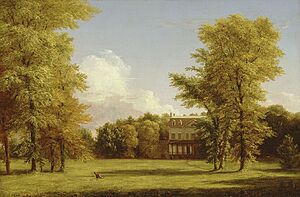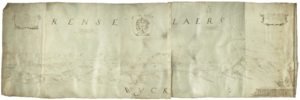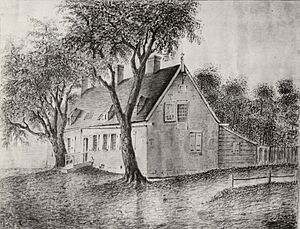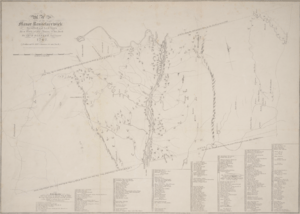Rensselaerswyck facts for kids
Quick facts for kids
Rensselaerswyck
|
||
|---|---|---|
|
||

Map of Rensselaerswyck, c. 1632
|
||
| Country | Netherlands | |
| Colony | New Netherland | |
| Rensselaerswyck | 1630 | |
| Government | ||
| • Type | Feudal patroonship, Proprietary colony | |
| Population
(1839)
|
||
| • Total | About 3,000 | |
Rensselaerswyck was a large estate in what is now New York. It was first owned by the Dutch and later by the English. This special type of land ownership was called a patroonship by the Dutch and a manor by the English. It was controlled by the van Rensselaer family for over 200 years.
The land was given by the Dutch West India Company in 1630 to Kiliaen van Rensselaer. He was a Dutch merchant and one of the company's leaders. Rensselaerswyck stretched for many miles along the Hudson River. It covered most of the land that is now Albany and Rensselaer counties. It also included parts of Columbia and Greene counties.
Under the patroonship system, the patroon (the owner) had a lot of power. They could create laws, set up villages, and even start churches. Farmers worked the land, but they were tenants. This meant they had to pay rent to the patroon. If a farm was sold, the patroon also received a share of the money.
The van Rensselaer family kept the estate for more than two centuries. By 1839, Steven van Rensselaer III was one of the richest Americans. After he died, his sons inherited the land. However, tenant farmers began to protest the system. They didn't want to pay rent anymore. Because of these protests, the van Rensselaer family sold most of their land in the 1840s. This ended the patroonship. Rensselaerswyck was the most successful patroonship created by the Dutch West India Company.
| Rensselaerswyck series | |
|---|---|
| Dutch West India Company |
|
| The Patroon System |
|
| Map of Rensselaerswyck |
|
| Patroons of Rensselaerswyck: Kiliaen van Rensselaer |
|
Contents
Starting the Patroonships
In 1609, Henry Hudson explored the Albany area. The Dutch claimed this land and called it New Netherland. They built two forts there: Fort Nassau in 1614 and Fort Orange in 1624. Both forts were named after the Dutch royal family.
In 1620, the Dutch West India Company was formed. This company had huge power in the New World. They could make deals with local leaders, build forts, and manage trade.
To get rich people to invest in the colony, the company offered special deals in 1630. Any company member who started a colony of 50 adults within four years would become a "patroon." The only rule was that the colony had to be outside Manhattan island.
The company created the Charter of Freedoms and Exemptions. This charter set rules for farming colonies.
- A colony could be 16 miles long on one side of a river.
- It could be 8 miles long if it was on both sides of a river.
- The land could also stretch inland and get bigger if more people settled there.
Each patroon had great power within their colony. They had the only rights to fish and hunt. If a town was built, the patroon could set up local leaders and courts. Patroonships also didn't have to pay taxes for ten years.
Colonists had to agree to stay in the colony. They could not leave without the patroon's permission. The West India Company even promised to catch and return anyone who ran away.
However, colonists had some limits. For example, they could not trade furs. That was only for the Company. But patroonships could trade in other goods from Newfoundland to Florida. They just had to stop in Manhattan first.
Patroons also had to buy land from the local American Indians. They couldn't just take it. The Company also promised to protect all colonists from attackers. They also agreed to provide "blacks" (enslaved people) to the patroonship if needed.
Starting the Manor


Kiliaen van Rensselaer was a rich merchant from Amsterdam. He was one of the first to use the new settlement rules. In 1629, he sent people to find good places for a colony.
On April 8, 1630, van Rensselaer's agent bought a large piece of land from the local American Indians. This land was next to Fort Orange, on the west side of the Hudson River. It stretched far inland.
Van Rensselaer quickly prepared to send settlers. In the spring, many people, with their tools and animals, sailed from the Netherlands. They arrived at Fort Orange and began to develop the Manor of Rensselaerswyck.
Soon after, van Rensselaer's agent bought more land from the Indians. This land was mostly north of Fort Orange. It reached up to the Mohawk and Hudson rivers. These purchases completed the manor's borders on the west side of the Hudson.
Every tenant had to promise loyalty to the patroon. They swore an oath to be faithful and not cause trouble.
Land on the east side of the river was also bought from an Indian chief. This land was called "Semesseck." These purchases were made in August 1630. They were approved by the council in Manhattan. Fort Orange and the land right around it remained under the West India Company's control. This area later became the city of Albany, which was never part of the patroon's land.
Van Rensselaer's large land purchase made other rich people jealous. So, he divided his estate near Fort Orange into five parts. He hoped this would help the colony grow faster.
He kept two parts for himself. He gave one part each to Johannes de Laet, Samuel Godyn, and Samuel Blommaert. These men were important members of the West India Company. Over time, these three separate patroonships were bought back and became part of Rensselaerswyck by 1685.
Life and Culture
In the early days, Rensselaerswyck had three groups of people.
- Freemen: These were people who paid their own way from Holland.
- Farmers: These were tenants who worked the land.
- Farm servants: These were sent by the patroon and were at the bottom.
The first patroon, Kiliaen van Rensselaer, used his money to help the estate grow. He set up farms on both sides of the river. He built houses, barns, and stables. The patroon also provided animals like cattle and horses. He gave them wagons, plows, and other tools. This way, early farmers could start without needing a lot of money.
In 1642, a minister named Johannes Megapolensis came to Rensselaerswyck. He was the first minister there. A surgeon, Abraham States, and a brewer, Evert Pels, also arrived. Pels built the first brewery in the Dutch colony.
Keeping the Manor Going
:List of Patroons
|
|||||||||||||||||||||||||||||||||||||||||||||||||||||||||||||||||||||||||||||||||||||||||||||||||||||||||||
It is believed that Kiliaen van Rensselaer, the first patroon, never actually visited his land in New Netherland. The estate was passed down through his family.
His oldest son, Jan Baptist, became the next patroon. After he died, his younger brother Jeremias van Rensselaer took over. In 1664, the English took over New Amsterdam and Fort Orange from the Dutch. Jeremias accepted this change. In 1666, he built the original Manor House, also known as Fort Crailo. This house was the main office and home of the patroon until 1765.
Jeremias died in 1674. His oldest son, Kiliaen Van Rensselaer, became the patroon. He was only eleven, so his mother, Maria van Cortlandt van Rensselaer, managed the estate until he was old enough.
In 1683, New York Governor Thomas Dongan created Albany County. This county included Rensselaerswyck. In 1685, Governor Dongan officially recognized Rensselaerswyck as a legal entity. He described its exact borders.
A year later, in 1686, Albany became a city. It was never directly controlled by the patroon. Kiliaen, as patroon, held many political jobs in Albany. He served as an assessor, a judge, and a supervisor. He also represented Rensselaerswyck in the New York General Assembly.
In 1704, Kiliaen divided Rensselaerswyck into two parts. The southern part, called the "Lower Manor," was managed by his brother Hendrick. The northern part kept the name Rensselaerswyck.
Kiliaen died in 1719. His oldest son, Jeremias, became the next patroon. Jeremias died in 1745, and the estate went to his brother Stephen. Stephen was sick and died two years later in 1747.
The estate then passed to Stephen's son, Stephen van Rensselaer II. He was only five when his father died. Stephen II worked to fix land leases made by earlier patroons. A town called Stephentown was named after him. He also rebuilt the Manor House in 1765.
Stephen II died in 1769 at age 27. He was one of the richest men in the area. The Manor went to his oldest son, Stephen van Rensselaer III. He was also five when his father died. Abraham Ten Broeck managed the estate until Stephen III turned 21.

Stephen van Rensselaer III became very famous for his many achievements. He was elected to the New York State Assembly and later the New York State Senate. He also served as Lieutenant Governor of New York. In 1822, he was elected to the United States House of Representatives. He was also a general in the New York State Militia. His most lasting achievement was starting the Rensselaer School, which is now Rensselaer Polytechnic Institute.
The Anti-Rent Movement and End of the Manor

Stephen III lived to be 75 and died in 1839. He was known as "The Good Patroon" and "The Last Patroon." At his death, he was worth a lot of money. He was one of the richest Americans in history.
Stephen III had been very easy on his tenants about collecting rent. This created a big problem for his sons. His will said they had to collect all the unpaid rent to pay off his debts. As soon as rent notices went out, the farmers protested.
Stephen IV, who inherited the western part of the manor, refused to meet with the protesting farmers. His refusal made them very angry. In July 1839, a large meeting called for independence from landlord rule.
The estate's managers then tried to force tenants to pay. They got court orders to remove farmers who hadn't paid. But angry crowds of tenants fought back. The sheriff and his helpers were pushed around. Even a group of 500 men helping the sheriff couldn't control the tenants. The governor sent soldiers, but the tenants still refused to pay.
By 1844, the anti-rent movement had grown. It was no longer just about the van Rensselaer family. It was a fight against the whole system of renting land across eastern New York. Some riders dressed as Native Americans and wore calico gowns. They rode through the countryside, scaring the landlords' agents. There was even some violence. In 1845, an undersheriff was killed during an eviction sale.
The anti-renters organized groups and published their own newspapers. They held meetings and elected people to the state legislature. Their success in elections made politicians pay attention. The legislature passed laws that helped the tenants. For example, landlords could no longer easily take a tenant's goods if they didn't pay rent. They also taxed the income landlords made from rent.
In 1846, a new state constitution was written. It said that no new farm leases could last longer than twelve years if they required rent. However, it didn't change existing leases.
The anti-renters continued to be successful in politics. They elected sheriffs and local officials who made it hard for landlords to collect rents. They supported candidates who would help their cause. This gave them more power than their numbers might suggest.
Eventually, the courts ruled that landlords could not charge a "quarter sale." This was a rule in many leases that said a tenant had to pay one-fourth of the sale price to the landlord if they sold their farm.
Faced with tenants refusing to pay and new laws, the landlords slowly sold their land. In 1845, Stephen IV agreed to sell his rights in some townships. His brother, William, who had the eastern part of the manor, sold his rights to over 500 farms in 1848. Finally, in the 1850s, two buyers purchased the remaining leases from the van Rensselaers. This brought an end to the long history of Rensselaerswyck.







